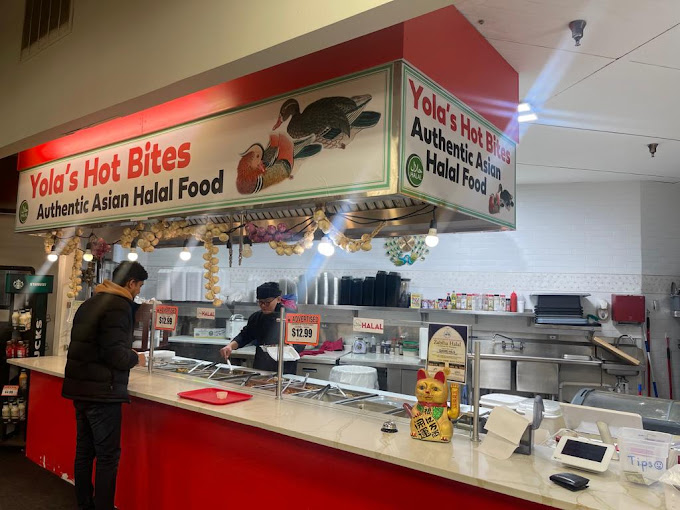Best Ambiance Restaurants Islamabad: Perfect Spots for an Unforgettable Meal
Best Ambiance Restaurants Islamabad: Perfect Spots for an Unforgettable Meal
Blog Article
Savor Authentic Asian Food With a Pan-Asian Twist for a Culinary Journey
Starting a culinary journey via authentic Oriental cuisine, enhanced with a Pan-Asian twist, provides a special chance to check out the rich tapestry of tastes that specify the area's diverse cooking customs. This experience welcomes you to savor the elegant balance of preferences-- pleasant, salted, spicy, and sour-- integrated by aromatic natural herbs and flavors. Visualize the cutting-edge blend of Thai curry and ramen or the unanticipated joy of sushi burritos. As you consider these attracting recipes, take into consideration the social stories and historic influences that shape them, each bite supplying a story waiting to be found.

Discovering Pan-Asian Flavors
In the realm of international gastronomy, Pan-Asian cuisine attracts attention for its amazing diversity and the unified interaction of tastes from different Oriental cultures. This culinary approach celebrates the rich traditions and special active ingredients located across the continent, developing a tapestry of tastes that is both satisfying and appealing. Trick to Pan-Asian cuisine is its ability to stabilize contrasting tastes-- pleasant, salted, spicy, and sour-- while highlighting the quality and top quality of each ingredient.
From the umami-rich soy sauce of Japan to the fiery chili peppers of Thailand, Pan-Asian food uses an extensive palette of flavors. These elements are commonly integrated in inventive methods, boosting meals with layers of complexity. For circumstances, making use of aromatic herbs such as lemongrass and cilantro, usual in Vietnamese and Thai cuisine, adds a refreshing brightness to dishes, while the unification of coconut milk supplies a velvety, abundant structure.
The emphasis on fresh produce and aromatic seasonings makes certain that each dish is not just a feast for the preference buds yet also for the senses. Pan-Asian food invites restaurants to start a cooking trip, exploring the large and differed landscapes of Asian gastronomy with every bite.
Combination Recipes to Attempt
While Pan-Asian food is commemorated for its standard flavors, the modern cooking landscape is increasingly welcoming combination dishes that mix these timeless aspects with influences from other areas. This innovative approach not only honors the abundant heritage of Asian culinary arts but additionally introduces unique preference experiences that attract contemporary tastes.
An archetype of such a blend dish is the Korean-Mexican taco, where marinated bulgogi beef is wrapped in a warm tortilla, topped with kimchi and a spicy gochujang-infused salsa. This combination marries the bold, tasty tastes of Korea with the vivid, fresh elements of Mexican cuisine. Similarly, sushi burritos have gained popularity, integrating the fragile creativity of Japanese sushi with the passionate, hand-held comfort of a burrito, typically featuring fusion ingredients like tempura shrimp and avocado with a drizzle of wasabi mayo.
An additional significant meal is Thai curry ramen, which instills the creamy, aromatic flavors of Thai curry into the reassuring brew of traditional Japanese ramen, creating a harmonious mix that entices the senses. These blend dishes prolong past plain novelty; they represent a culinary dialogue in between cultures, urging expedition and development in the globe of Pan-Asian cuisine.
Important Active Ingredients and Seasonings
To genuinely appreciate Pan-Asian food, one need to recognize the necessary components and spices that form its structure. This diverse culinary style attracts from an abundant tapestry of Eastern customs, utilizing a harmonious mix of appearances and flavors. Key components consist of soy sauce, fish sauce, and oyster sauce, which pass on a tasty umami depth vital to Oriental meals. Corresponding to these are rice vinegar and mirin, providing a delicate level of mr wong acidity and sweetness.
Aromatic aspects are pivotal, with lemongrass, ginger, and garlic being ubiquitous across numerous Pan-Asian dishes. These active ingredients give an aromatic base that enhances the complexity of flavors. Spices such as celebrity anise, cardamom, and cinnamon present heat and character, resembling impacts from regions like China and India.

Food Preparation Techniques and Tips
Mastering the art of Pan-Asian food requires knowledge with its distinct cooking strategies, each adding to the dynamic tapestry of tastes this cooking practice is commemorated for. Central to these approaches Check This Out is the stir-fry, a fast cooking method that preserves the dietary honesty and vibrant colors of active ingredients. Utilizing a wok, the stir-fry method allows for even heat distribution, important for accomplishing the particular texture and flavor equilibrium of Pan-Asian dishes.
Another essential technique is steaming, specifically widespread in Chinese food. This mild technique maintains the natural flavors and nutrients of ingredients, making it optimal for fish and shellfish and veggies. Dumplings, a beloved staple, often take advantage of steaming, leading to soft, delicious textures.
Barbecuing, also integral, presents great smoky depths to recipes such as Oriental bulgogi or Japanese yakitori (asian restaurant isb). This method typically includes marinading active ingredients, enabling flavors to permeate deeply before food preparation over an open flame or hot plate
Finally, grasping the art of stabilizing tastes-- sweet, sour, salty, bitter, and umami-- is critical. Appropriately layering these aspects can boost a recipe from common to extraordinary, offering a complex and pleasing culinary experience that symbolizes the essence of Pan-Asian food.
Eating Experiences Worldwide
Around the world, Pan-Asian cuisine supplies an unrivaled eating experience, celebrated for its rich tapestry of tastes and vibrant discussions. This culinary sensation has transcended social limits, catching the hearts and tastes of food lovers worldwide. In worldwide cities like New York, London, and Sydney, Pan-Asian restaurants work as fusions where cooking practices from Thailand, Japan, China, and past assemble, offering restaurants with an eclectic mix of recipes that highlight the region's diversity.
The global allure of Pan-Asian food next hinges on its capability to use both credibility and innovation. Chefs masterfully wed traditional components such as lemongrass, soy sauce, and miso with modern methods, resulting in recipes that are both refreshingly brand-new and familiar. This combination enables restaurants to start a cooking journey that appreciates heritage while embracing modernity.
Additionally, eating experiences are boosted with attentively created environments that show the principles of Pan-Asian appearances. From minimalist Japanese-inspired insides to lively Thai-themed spaces, each restaurant uses a special setting that complements the cooking offerings. Because of this, customers are not merely consuming a dish however partaking in a cultural experience, making Pan-Asian eating a really international phenomenon.
Verdict
The exploration of Pan-Asian food provides a profound understanding of the elaborate interplay of tastes and cooking customs across Asia. By embracing combination dishes such as Thai curry ramen and sushi burritos, the culinary trip not only highlights the adaptability of conventional ingredients yet also showcases cutting-edge contemporary strategies. This gastronomic experience, enriched by cooking techniques and vital spices, provides a distinct possibility to appreciate the multiculturalism and culinary virtuosity that specify Pan-Asian cuisine on a global scale.
Embarking on a culinary trip through authentic Eastern cuisine, boosted with a Pan-Asian spin, provides an one-of-a-kind possibility to discover the rich tapestry of tastes that define the region's varied culinary traditions.In the realm of worldwide gastronomy, Pan-Asian food stands out for its remarkable variety and the harmonious interaction of tastes from different Asian societies. Trick to Pan-Asian food is its capability to balance contrasting flavors-- wonderful, salty, spicy, and sour-- while highlighting the freshness and high quality of each component.

Report this page